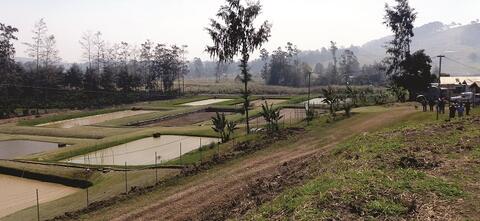Working across disciplines and sectors to optimise land-based aquatic food security
Our aquaculture team includes expertise in inland aquaculture. We work across disciplines and sectors, and with a global aquaculture network, to find solutions to enable our members to fulfil their aquaculture aspirations.
If aquaculture is “the farming of aquatic organisms including fish, molluscs, crustaceans and aquatic plants” [see the FAO definition of aquaculture], then inland aquaculture is aquaculture that is located in inland areas rather than in the sea. Because seawater can be pumped onto land and used to fill ponds or tanks, inland aquaculture can include marine and brackish-water organisms as well as freshwater organisms.

Inland aquaculture systems
Inland aquaculture systems encompass all technologies and levels of intensity, from earthen ponds dug into the ground to floating cages of fish in rivers and lakes. In extensive pond systems the fish are held captive but forage on aquatic foods that grow naturally. In semi-intensive systems, supplementary feed is added by the farmer. In intensive systems, oxygen must also be added by mechanical aeration of the water. Super-intensive systems may be indoor tanks inside a warehouse which can use water heating along with high-tech water treatments, such as Recirculating Aquaculture Systems (RAS). There is scope for integration of inland aquaculture with agriculture into “circular” systems with recycling of water and nutrients (integrated agri-aquaculture, and aquaponics).
The support we provide
At SPC FAME we provide capacity-building and capacity supplementation to assist member countries and territories to achieve their aquaculture goals. We consult with public and private sectors and civic society to find out the challenges and constraints, and to design with them activities and interventions to support their progress in aquaculture.
We work closely with our member counterpart ministries and their partners in private-sector or communities to implement activities. We design and carry out collaborative trials, assist members to transfer new technologies or adopt new techniques, and help them design infrastructure like hatcheries and nurseries. We monitor new and emerging types of aquaculture and assess their suitability for adoption in the Pacific region. If we are alerted to new threats, such as climate change impacts or pests and diseases that affect aquaculture, then we assist our members to take precautionary steps and build resilience.
We assist our members in establishing production and moving further along the value chains. Our interventions span natural and social sciences to address the challenges that exist around this industry, such as feed, seed and equipment supplies; transfer of technology; and developing a good understanding of the aquaculture market. All aquaculture must be market-driven: appreciating the appeal of the products in terms of their quality, price and nutritional contributions to healthy diets is key to a sustainable business.
